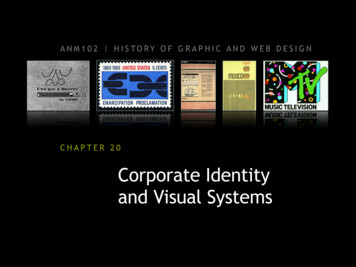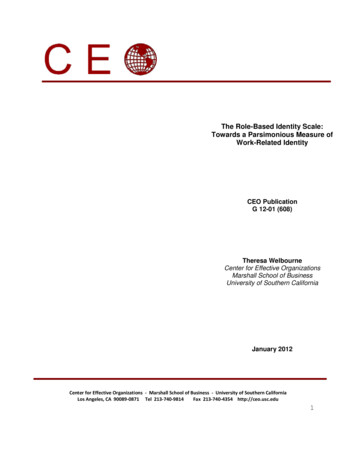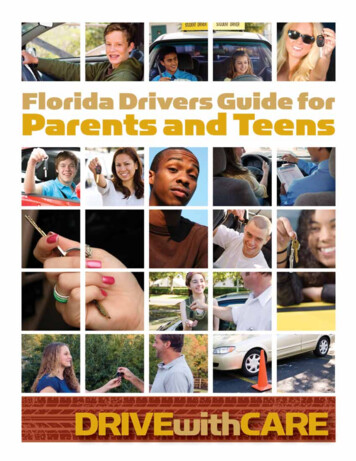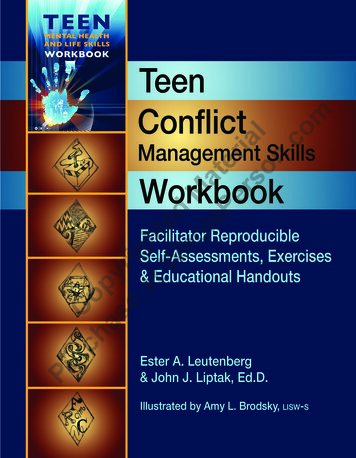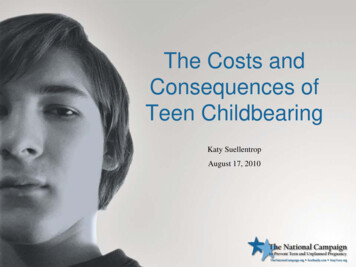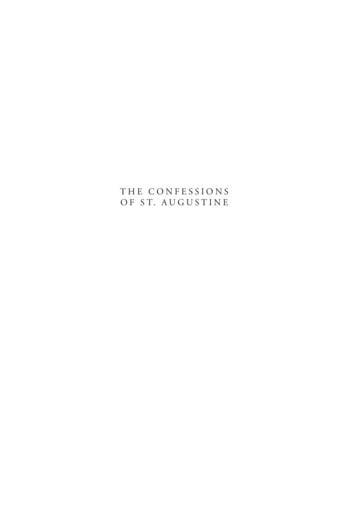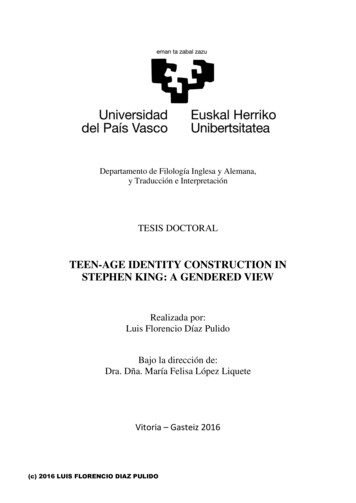
Transcription
Departamento de Filología Inglesa y Alemana,y Traducción e InterpretaciónTESIS DOCTORALTEEN-AGE IDENTITY CONSTRUCTION INSTEPHEN KING: A GENDERED VIEWRealizada por:Luis Florencio Díaz PulidoBajo la dirección de:Dra. Dña. María Felisa López LiqueteVitoria – Gasteiz 2016(c) 2016 LUIS FLORENCIO DIAZ PULIDO
ACKNOWLEDGMENTSAfter a long and hard journey, I have finally reached my destination. The pagescontained in this dissertation are the product of never-ending research and endless hoursof thinking, writing, correcting and checking the Internet looking for information andpeople wiser than me that could help me develop my ideas.The adventure started for me long time ago with an illusion, a starting point and anuncertain outcome. I would like first give thanks to my family and friends for toleratinglong – and sometimes tedious for them – conversations on terror, movies, Stephen Kingand anything that thrills me. Without their continuous emotional support, thisdissertation would have been impossible.Of course, to confront such an astounding academic task, every rookie apprenticeneeds a mentor figure, a tutor. In this case, in my long and intermittent academic life, Ihave enjoyed the advices and tutoring of nothing but three magnificent people andscholars. To Professor Federico Eguíluz, whenever you are: I did it! Thanks for helpingme to give my first steps and infusing me with the attracting literary worlds of EdgarAllan Poe to develop my MA. This gratitude is also applicable to Eterio Pajares, whoaccepted me in a moment of uncertainty after Federico Eguiluz left us, and after that, hewas sincere enough to abandon me again because he felt that my way was mine but nothis.Last but not least, I give special thanks to Professor María Felisa Lopez Liquete, theperson who helped me to write this dissertation and reset my mind. Thanks, Feli, foryour time, advices, corrections and talks. Without your academic support, thisdissertation would have been impossible.
INTRODUCTION1Chapter One: CarrieOrigins and Antecedents in Fact and Fiction9Feminine Powers Unleashed20Tomboys: of Bad and Horrible MothersTomboys, Part II: Perfect Partners, the Good Girl and the Bitch GoddessCinderella's Apocalyptic Revenge: Kill the Mother and Run AwayThe Consumption of FemininityChapter Two: ChristineTechnology Made Flesh: the Human Machine41Metaphorical VehiclesConsuming Masculine Powers48Manhood in AmericaThe Failure of the Self-Made ManCars and Girls as Consuming GoodsThe Father Usurps the SonAvoiding the Gay Side of ThingsMasculinity, the Disposable GenreChapter Three: “The Body”Assimilating Death and Legacy69The Bodies in “The Body”Gordon's RebirthA Cold War Western: Cowboys without Hat, Pioneers without LandSaving the Day, but not LifeAssimilating Death and (Lack of) LegacyChapter Four: The TalismanFacing Reality as It is99Fantasy for Dummies: Definition and RulesThe Talisman, an Old Modern MythThrough a Glass Darkly: the World of The Talisman and Reagan's AmericaThe Hero's Journey: SeparationCrossing Thresholds, Reagan's Policies and the Unbalance of the Feminine Principle138
Roads, Trials, Enemies and another ThresholdOf Wolfs, Men and Transformative StagesThe Hero's Journey: Initiation166Defeating the Father FigureKing and Straub, Raiders of an Alternative MasculinityChapter Five: ItDefeating Fear, Cha(lle)nging Patriarchy189Pennywise, the Ambiguous Villain of a Cultural WarFlawed Heroes in a Democratic MythDefeating It as Children: a Youthful VictoryDefeating It as Adults: an Incomplete ResolutionCONCLUSION239WORKS CITED251
INTRODUCTIONFor four decades, Stephen King has been creating worlds that are enthusiasticallyvisited by literally millions of readers. He is, undoubtedly, one of the most recognizablewriters of American fiction. However, it is this recognition, this popularity that has inthe past stifled King's acceptance in the academia. Many scholars repudiate StephenKing as a pulp fiction writer regurgitating only one kind of story for cheap thrills withan impossible, superhuman, and often annoying, regularity. On the other hand, othercritics maintain that “Anything so popular for so long merits attention, whether it isStephen King, The Beatles, the Ford Mustang, or William Shakespeare” (Davis 8).Nowadays icons of a globalized world culture, The Beatles and William Shakespearewere once common. Yes, even William Shakespeare was to an extent dismissed by theintellectual elites of his times as popular “junk,” but we come to learn that, in literatureas in life, time puts things in their proper place and that “popular items of onegeneration become the classic items of the next” (Davis 9).Now, only time will tell whether King's works will endure long enough to beconsidered iconic or classic, but two things are evident: Stephen King is highly popular,and he is widely read outside the academic world. The fact is that there is an apparentlyinsuperable breach between Stephen King and academics, between popular and highculture. Maybe, the ambivalent personification of this rupture, of this scornful definitionof popular as something “suitable for ordinary people rather than experts”(mcmillandictionary.com) is critic Harold Bloom who, despite defining Stephen King as“a sociological phenomenon, an image of the death of the Literate Reader”(“Introduction” 3) or despising him as an “immensely inadequate writer on a -bookbasis,”(“DumbingDownAmerican Readers”) has published to date with Chelsea House three editions ofcollected essays about King's fiction for which he has both edited and writtenIntroductions; this suggests at least that he appreciates King's undeniable marketability,if not his significance as an American literary figure.Anthony Magistrale suspects that Bloom's point is to relegate King's place inAmerican popular culture to an ephemeral commodity of our disposable epoch thatcarries no real significance beyond its moment in time and certainly not worthy of being1
recognized as literature (“Why Stephen King Still Matters” 355). For him, this wouldexplain why Professor Bloom was so incensed when Stephen King won the NationalBook Awards' annual Medal for Distinguished Contribution to American Letters in2003. However, if Stephen King will only be remembered as a sociologicalphenomenon, there are other, more insightful ways of interpreting him sociologically.His novels and stories are not merely cheap thrills to consume fast but, as AnthonyMagistrale himself points out elsewhere, at the heart of his best work there is “a deepseated awareness of the very real anxieties about how Americans live and where are wegoing, as nation and individuals” (America's Storyteller ix).These anxieties are expressed in Gothic terms because Stephen King has beenpigeonholed as a master in horror literature, but his best stories transcend this genre tooverlap others. In fact, this dissertation is not merely the study of a literary genre, but away to offer a sociologically relevant discourse analyzing Stephen King's fiction. Astarting point for this analysis would be to acknowledge that, much to Harold Bloom'sdistress and desperation, Stephen King embodies the birth of the Non-Literate Readerbecause his books are so compelling that they have attracted people who normally donot read much of anything, let alone thousand-page novels. Particularly, teenagersdevour his books with passion.Maybe, this is so because the majority of his early production, the one which gavehim fame and money, and the one this dissertation will be focused on, is crowded withteenagers and children they can identify with or not. Since Carrie reached thebookstores in 1974 to the mid - 1980s, Stephen King has published twelve novels withinfants and bags of hormones in their pages: Carrie, Salem's Lot, The Shining, TheStand, Firestarter, Cujo, Pet Sematary, Christine, Cycle of the Werewolf, It, The Eyes ofthe Dragon and the collaborative experiment The Talisman with Peter Straub. Apartfrom this, other narratives by King such as The Dead Zone and The Dark Half, severalcollections of short stories such as Night Shift or Skeleton Crew, collections of novellaslike Different Seasons, with stories such as “The Body” or “Apt Pupil,” a seminal essayabout horror where he gives his personal opinion concerning how the genre works,Danse Macabre, his fictions have been translated into motion pictures that have madehim omnipresent in American popular culture and society; and if the American literarymarket were not saturated enough by his pen, he published several novels using thepseudonym of Richard Bachman, such as Rage, The Long Walk, The Running Man,2
Roadwork and Thinner which became instant hits once people knew Stephen Kingwas behind the pseudonym.The writer could have died of success, but this was not the case. Encouraged byfeminist critics who labeled him as unable to write a believable female character fromsixteen to sixty-four – famous literal words asseverated by King critic Chelsea QuinnYarbro (“Cinderella's Revenge” 9) – he embarked in a different period in his writing inthe 1990s approaching strong and believable women. Novels such as Misery, DoloresClaiborne, Gerald's Game or Rose Madder are hugely appreciated by scholars ofgender studies. He combined this trend with his most usual fantastic stories publishingThe Green Mile or Desperation, another Bachman book, The Regulators and collectionsof short stories such as Nightmares and Dreamscapes and Hearts in Atlantis, or anothercollection of novellas, Four Past Midnight, until an accident in 1999 almost killed andmoved him away from writing. In the first decade of the twentieth-first century, heresumed work completing his anxiously desired and critically praised saga of The DarkTower with the novels Cell, Lissey's Story, Under the Dome and the collection of shortstories Everything is Eventual acquiring certain literary relevance. Meanwhile, hisfructiferous collaboration with Peter Straub came up with The Black Hotel. His mostnoteworthy book in the last five years is 11/22/63, which brings back the earliernarratives combined with a fine craft of writing. In addition, he has published thecollection of short stories Full Dark, No Stars and continues using the name of RichardBachman (Blaze), while his essay on the craftsmanship of writing titled simply OnWriting has become essential to understand his profession and vocation.As mentioned at the beginning of this introduction, his prolific production does notmatch his critical reception. Due to his huge popularity, mainly in his early career, abunch of brave scholars began to pay attention to his works and books of criticism suchas the seminal The Art of Darkness (1984) by Douglas Winter appeared. The collectionof academic articles The Gothic World of Stephen King (1987) by Gary Hoppenstandand Ray Browne remains essential to analyze some of the early productions of theauthor, and critics and scholars such as Anthony Magistrale, Michael Collings or HeidiStrengell have researched King's literary production in depth. When the Stephen King'sboom returned to normal, the criticism of his work remained relatively regular. One ofthe highlights in criticism of the Stephen King oeuvre is the collection of academicarticles about gender studies in Stephen King's fiction contained in the volume3
Imagining the Worst: Stephen King and the Representation of Women (1998) edited byKathleen Lant, from which several articles have been reprinted in different collectionsof essays, including those by Harold Bloom. In fact, seminal academic articles are reedited once and again for the use of literary scholars and students. With the main focusin his early career, it is not a surprise that his more recent literary production is still outof sight. Particularly, King's much praised Dark Tower saga has a little recent niche ofscholarship inaugurated by Robin Furth and her The Dark Tower: the CompleteConcordance (2006).This lack of serious attention from the academe is not shared by students at theuniversity, who have researched the work of Stephen King with tenacity. It is not asecret that the majority of the main characters in Stephen King's canon are male, andthis fact has not gone unnoticed by gender scholars. However, when analyzing the maincontributions, most of them seem to be relegated to seminal individual works.Particularly, The Shining (1977) in “From Big Sticks to Talking Sticks: Family, Workand Masculinity in Stephen King's The Shining” (2000) by Stephen Davenport, andMisery (1987) in “Your Legs Must Be Singing Grand Opera: Masculinity, Masochismand Stephen King's Misery” (2002) by Douglas Keesey; Kathleen Ann Sullivan hasanalyzed the construction of masculinity in the works of Stephen King and Peter Straubin Suffering Men / Male Suffering: the Construction of Masculinity in the Works ofStephen King and Peter Straub (2000) sticking exclusively to “The Body” (1982) and“It” (1986). His feminine characters have stimulated controversy, and their meaning anddepth are the focus of several studies. The aim of this dissertation is to open thediscussion about gender in Stephen King's fiction. Since there are children in almostevery major story by King, it seems relevant to choose stories with teenagers as maincharacters driving the plot and see how they reflect gender because, as it has beenpreviously mentioned, King's canon appeals to teenagers. In fact, the whole study isnothing less than a gendered view of the construction of teen-age identity in the literaryfiction of Stephen King. In this particular vision, the concept of power is fundamental.The stories approached in this dissertation have been chosen taking intoconsideration a few reasons. To begin with, although it is true that most of the childrenand teenagers in Stephen King's production are boys, there are also girls. Carrie (1974)was the first published novel by King, and for me, it is the starting point to begin thedissertation because the following statement by Kathleen Ann Sullivan is worthy of4
analysis: King's fiction is the unintended consequence of 1970s feminism (“BookishBoys”). Maybe, the notion of power seems relevant to prove Sullivan's statement.Other reason considering the election of the primary bibliography for the research is thefact that Stephen King has written in several formats, including short stories andnovellas. Therefore, those formats deserve scrutiny and, at least one of them should beincluded in the analysis. Finally, the main characters of these stories drive the plot, theyare not secondary, and being teenagers, their ages range from 12 to 18. Criteria excludefrom the analysis almost all the early novels by Stephen King including Salem's Lot,The Shining, The Stand, Firestarter, Cujo or Pet Sematary, among others.Trying to insightfully interpret him sociologically, I have chosen stories that allowthe construction of a discourse about masculinity in his fiction. If his production is theunintended consequence of 1970s feminism, what is the author's answer to thismovement? How is masculinity reflected in his fiction? If there is an internal discourseabout masculinity, is this discourse appropriate for the teenagers who devour his books?Are there any deviations in that discourse? Are these deviations desirable? His novelsdo not live in a vacuum, and they are the product of his times, which are ours. What thisdissertation tries to prove is that the very real anxieties about how Americans live andwhere they are going as individuals and nation are gendered in nature.The first chapter in this dissertation analyzes Carrie (1974) in depth. In “Origins andAntecedents in Fact and Fiction,” the literary Gothic roots of the character are tracedwhile, at the same time, it is explained where its true origins are. “Feminine PowersUnleashed” approaches the novel from a psychoanalytical, feminist point of viewconsidering the text as an amalgamation of feminist anxieties about power and gender.Masculinity concepts become relevant to explain the behavior of the main characters,teenage girls attracted to the apparently great freedoms enjoyed by boys. From asociological point of view, the story reproduces a patriarchal system to which thecharacters try to conform. As a matter of fact, Carrie shows how patriarchy works forwomen and girls.The second chapter takes into consideration Christine (1983) as a late mirror of thepreviously analyzed novel. “Technology Made Flesh: the Human Machine” looks forthe possible science fictional roots of the story, while “Consuming Masculine Powers”talks about masculinity and power. The story explains how patriarchy works for menand boys. Under the premises of the work of Warren Farrell, the myth of male power is5
put in a quandary. The novel demolishes the myth of the self-made man, essential inAmerican culture, and explains how and why the disposability of masculinityperpetuates patriarchy. In short, Christine is a metaphor about the lack of male power.The third chapter considers “The Body” (1982) a reboot of the study. In“Assimilating Death and Legacy,” the novella included in the collection DifferentSeasons brings to the surface American cultural demons, and provides a mythologicalcontext to the loss of American (male) innocence and to the perpetual crisis ofmasculinity American men seem to suffer since the raise of feminism in the 1960s. Arealistic coming of age narrative, the story tries to exorcize culturally constructed(gendered) malaises of American society through a cathartic experience that allowsAmerican readers to assimilate a historical and cultural legacy they seem to ignore.Moreover, it provides an explanation to the current rejection of certain hegemonicdiscourses of gender; to the moment when being a lonely, tough and dominant manbecame a curse instead of a blessing.The fourth chapter goes deep into the realms of fantasy for a better understanding ofThe Talisman (1984), the collaboration between Stephen King and Peter Straub. Thenovel, a Gothic quest, “faces (American) reality as it is”; it reveals the backroom of theReagan Era, and how the origins of the crisis of masculinity Americans seem to sufferwere culturally constructed and battled during those years. In fact, the journey the maincharacter, Jack Sawyer, embarks on becomes an attempt to even out the unbalance ofthe feminine principle in an American society rotten with racism, homophobia andsexism. The boy, an updated incarnation of the old modern myth of the AmericanAdam, begins “the Hero's journey” proposed by Joseph Campbell innocent, and hefinally turns into an idealized new alternative to the harmful, hegemonic models ofmasculinity Americans praise for a magical while. Of course, as we see this myth“through a glass darkly,” the experience for the boy is more traumatic than fulfilling.The last chapter of the study takes into consideration It (1986), a pseudo-farewell tothe horror genre and to everything Stephen King has to say about children andteenagers. The novel gives a fairy talesque closure and answer to the culturallyconstructed crisis of masculinity produced by the raise of feminism during the Reaganyears with a bunch of kids “Defeating Fear; Cha(lle)nging Patriarchy,” trying to kill aprotean, ambiguous monster which represents the worst traits of patriarchy and becomesthe villain of a cultural American war. The kids, flawed heroes of a democratic mythmade up in the 1950s, defeat It twice, both as children and adults. However, the happy6
ending hides a poignant message about current American society and its dystopianfuture.Since the raise of feminism in the 1970s, a cultural and perpetual crisis ofmasculinity disrupts the evolution and maturity of Americans. The novels of StephenKing tell how American society works, show its malaises and reflect teenageindividuals trying to deal with issues of gender and power. However, in spite ofmultiple threats and uncertainties, there is room inside the author's characters forimprovement and evolution.7
8
Chapter One: CarrieCARRIE INTO PERSPECTIVE: ORIGINS AND ANTECEDENTS IN FACTAND FICTIONCarrie (1974) was the first novel published by Stephen King. It supposed themeteoric starting point of his career as bestsellers' author and American pop cultureicon. With an uncertain and complicated origin,1 the story of Carietta White was anunexpected success for his creator and it can be considered the cornerstone over whichthe writer builds his particular vision of what it does mean to be an American(masculine) child and teenager.Paradoxically, it is not by chance that his first literary journey is the story of a girlwho suffers bullying at school. Beyond mere literary opportunism, there are manydifferent factors that contributed to the publication of the book and its subsequent rise tofame. In fact, the novel emerges in the proper breeding ground to make a deepimpression among readers. The 1970s decade was a very convulse one in more than asense. Vietnam War, the Watergate scandal or the oil crisis shattered the placid visionthe United States had about itself. In plain loss of innocence as a nation and as a worldsuperpower, American horror fiction found a way to articulate all the anxieties thiscountry was suffering by offering a radically different vision of what until that momenthad been acceptable. The main child characters who terrify the easy and bourgeois livesof their parents in such novels as Rosemary's Baby (1967) by Ira Levin, The Other(1971) by Thomas Tryon, The Exorcist (1971) by William Peter Blatty or The Omen(1976) by David Seltzer make a disturbing and perverse portray of childhood andadolescence as a real threat to the adult world. As Sobchack clearly states, from the earlyto mid-1970s and coincident with bourgeois society's negative response to the youth movementsand drug culture of the late 60s and early 1970s, generic emphasis was on the child not as aterrorized victim, but as cannibalistic, monstrous, selfish, sexual. The child was figured as analien force that threatened both its family and all adult authority that would keep in its place -1After many rejections from publishers, Stephen King was desperate and did not have any original ideasfor writing. The author decided to work on a short story called Carrie. He thought the opening scene inthe shower room unrealistic, so he threw the pages into the wastebasket. Luckily, his wife Tabitharetrieved them and urged him to continue. (S. Russell 7; King, On Writing 68)9
oppressed and at home (178). Furthermore, this trend also helped horror literature to enterthe mainstream.Prior to these novels horror literature was continuously available on the shelves, butit was in a way ghettoized, that is, only specialized audiences tasted it. The cinemaopened the door of this minor genre to wide audiences, as almost all the novelsmentioned before became very successful movies: Rosemary's Baby (1969) by RomanPolanski, The Exorcist (1973) by William Friedkin or The Omen (1976) by RichardDonner. Particularly, the screen adaptation of The Exorcist is very relevant, as itsastounding hit (including an Oscar for best adapted screenplay) stimulated movieproduction and made horror more attractive to publishers. From that moment onwards,horror motifs and archetypes were to be found everywhere.This Gothic revival and boom of the 1970s had extremely important consequences,being the most important one the fact that these series of novels and films perpetuatedthe tendency in American mass media to stigmatize and trivialize adolescence as anunimportant period in vital development. Teenagers seem to be individuals without anymoral or ethical code. The banality of different cinematographic sagas like Porky's orFriday the 13th the following decade proved it right. The hedonism and consumerism ofthe 80s influenced the representation of teenagers as superficial people even in morecritically acclaimed films such as Ferris Bueller's Day Off (1986) by John Hughes orFast Times at Ridgemont High (1982) by Amy Heckerling, which in 2005 was selectedfor preservation in the United States National Film Registry by the Library of Congressas being “culturally, historically or aesthetically significant” (Dirks).A similar tendency could be found in bookstores. The 1980s supposed a return toromance books for teenagers following the hard-edged realism of the 1970s. Theadolescent lives portrayed in the romances of the 1980s replicated the already unreallives found in the forties and fifties' version, a pattern mass-produced for a not so newtarget: teens. Actually, what the teenagers “wanted in the eighties was what their parentshad already been demanding – and getting – for a decade or more: genre romances andformulaic bodice-ripper-of-the-month gothic paperbacks” (Cart 38).Both Gothic and romance novels offered escape from life's cares and woes, evenwhen these formulas sold stereotypes appropriate for the conservative nostalgic climateof the Reagan era. The sugary mass-market paperback series appearing at the rate of onenew title per month reached its climax in 1985 when Perfect Summer, the super editionunder the rubric Sweet Valley High created by Francine Pascal became the first novel10
addressed to teenagers in reaching the New York Times paperback best-sellers list. Apartfrom Stephen King, horror and science fiction found a place within teenagers' mindswith Slumber Party (1985) by Christopher Pike, R.L. Stine's Blind Date (1987) orEnder's Game (1985) by Orson Scott Card.In fact, it is very useful to define and offer a brief history of what literature forteenagers is because my point is that, although Stephen King is a prolific author whomay be writing about adult themes and tropes, his literary production (at least his earlyfiction, the one we are dealing with in this analysis) can be considered as young adultliterature. For Donelson and Nilsen, literature for teenagers started in the United Statesin the nineteenth century with The Adventures of Huckleberry Finn (1884) by MarkTwain and Little Women (1868) by Louisa May Alcott. The founders of this genre, so tospeak, attacked the audience from two very different perspectives: the domestic femalelife and the adventurous male life2. Male adolescents' rebellions seem to gain themcertain degree of autonomy that women have always been denied, and this tendency hasnot disappeared. However, in England the so called young adult books started evenearlier because nineteenth century literature presents several early examples thatappealed to young readers (Garland 6): The Swiss Family Robinson (1812) by JohannDavid Wyss; Waverley (1814) by Sir Walter Scott; Oliver Twist (1838) and GreatExpectations (1860) by Charles Dickens; The Count of Monte Cristo (1844) byAlexandre Dumas; Tom Brown's School Days (1857) by Thomas Hughes; Alice inWonderland (1865) by Lewis Carroll; Kidnapped (1886) by Robert Louis Stevenson;The Jungle Book (1894) by Rudyard Kipling and Moonfleet (1898) by J. Meade Falknerare but a few examples.But if we assume all these novels were originally intended for an adult audience,then they would not be literature for teenagers. In the United States, in fact, this badlycalled genre possesses a well-defined and narrower nature. Simply, young adultliterature is fiction written, published and marketed for teenagers. According to thisdefinition, young adult literature started in the twentieth century, when adolescencebecame a separate state of being due to the work of psychologist and educationalistStanley Hall and thanks to his classic two volume massive work with that name of1904. After his work, adolescence became a process of turmoil, stress, and storm rather2Hilton and Nikolajeva contrast these different perspectives in that, whereas Alcott presents a powerfulsentimental ideology of the family as the idyllic locus of adolescence grow and accentuates the strongfamily bonds and loyalty among women, Twain writes the first Western novel of adolescence in itsintensive search for identity (3, 4).11
than a static concept like “boy” or “girl.” However, this drastic change did not translateinto fiction for the young. What is more, the sentimental tradition of writing aboutchildren for children just stretched to include the teen years. Rebecca of SunnybrookFarm (1903) by Kate Douglas Wiggin, Ann of Green Gables (1908) by Lucy MaudMontgomery or Daddy-Long-Legs (1912) by Jean Webster are three classic novels ofthe American realist canon that justify this statement.There are three novels that can be considered as turning points inside the genre in theUnited States: Seventeenth Summer (1942) by Maureen Daly, The Catcher in the Rye(1951) by J. D. Salinger and The Outsiders (1967) by S. E. Hinton. Daly's novel of firstlove was published for adults, and it gave rise to countless teen romances in the Fortiesand Fifties that captured the reader's imagination, introducing the clichés of theawkward first kiss, the embarrassing introduction to the parents, the romantic and unrealmoonlit boat rides, teenage jealousy and concerns about being sexually precocious.Salinger's masterpiece was also intended for an adult audience, but his HoldenCauldfield changed the popular image of children and their actual experiences in a postWorld War II period where McCarthysm limited open political expression. Holden'sfrank, foul and stream-of-consciousness language and image evoked the specter of realjuvenile delinquents and his alienation mirrored iconic movie stars as Marlon Brandoand James Dean. The 1960s and the 1970s mark the end of childhood (and, by extensionof adolescence) as a protected and innocent realm. Books portray bleak children andteenagers, and adults are incompetent, absent, negligent, or outright evil. S. E. Hinton'sThe Outsiders is the first book written by a teenager for teenagers and so, it inauguratesthe young literature canon according to the
Strengell have researched King's literary production in depth. When the Stephen King's boom returned to normal, the criticism of his work remained relatively regular. One of the highlights in criticism of the Stephen King oeuvre is the collection of academic articles about gender studies in Stephen King's fiction contained in the volume




